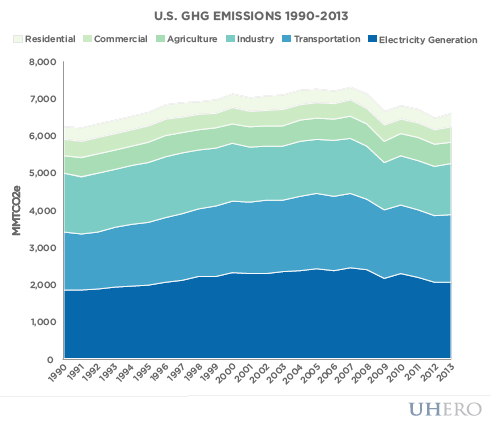By Paul Bernstein, Makena Coffman and Sherilyn Wee
In early August, President Obama announced and the U.S. Environmental Protection Agency (EPA) released the final details for the Clean Power Plan (CPP). These rules are designed to lower levels of carbon pollution from existing U.S. power plants – aiming to curb U.S. electric sector emissions by 32% from 2005 levels by 2030 (EPA, 2015a). The CPP is an important first step in making good on the U.S.’s global commitment to reduce economy-wide greenhouse gas emissions by at least 26% below 2005 levels by the year 2025 *.
Under the CPP, states have been given the choice of meeting either a rate- or mass-based goal for their existing fleet of power plants. In the draft version of the CPP, Hawaii was given a goal of reducing its emissions rate to 1,306 pounds of CO2 per MWh by 2030 (Carbon Pollution Emission Guidelines for Existing Stationary Sources: Electric Utility Generating Units, 2014). This target included energy efficiency gains and, given Hawaii’s Renewable Portfolio Standard goal of 100% renewable sources for net electricity sales by 2045 (and 40% by 2030), the CPP target was almost certainly achievable. Our modeling of Hawaii’s electric sector suggests that it was cost-effective to go beyond this draft target, even without factoring in energy efficiency.

Yet, Hawaii is not included in the last version of the CPP. Between the draft and final, the EPA based its decision on a continental grid-based modeling approach (EPA, 2015b). As such, non-contiguous regions are currently left without regulation. The EPA states that further regulations will be developed, though no timeline for completion has been given (EPA, 2015b). In addition, Hawaii is excluded from generating potentially valuable emission rate credits (ERCs), even if a target is determined in the future. The CPP regulations state that the “resources must be connected to, and deliver energy to or save electricity on, the electric grid in the contiguous United States.” This regulation unnecessarily excludes Hawaii (and Alaska and Puerto Rico) for geographic reasons, when economic markets do not have to be geographically bound.
One of the ways that the federal programs will regulate GHGs is to limit future coal-fired power. The New Source Performance Standards (NSPS) for the construction and operation of new power plants will effectively prohibit new coal units (without carbon capture) from coming online in the U.S., including Hawaii (Standards of Performance for Greenhouse Gas Emissions From New Stationary Sources: Electric Utility Generating Units, 2014). This of course is a positive outcome in terms of limiting future emissions and most relevant to coal-intensive states. In Hawaii, limiting new coal is something that the Hawaiian Electric Companies voluntarily agreed to in 2008. The NSPS makes this official **.
In sum, the EPA’s recent actions toward GHG emissions is important at the national scale but will have limited to no impact on Hawaii.
BLOG POSTS ARE PRELIMINARY MATERIALS CIRCULATED TO STIMULATE DISCUSSION AND CRITICAL COMMENT. THE VIEWS EXPRESSED ARE THOSE OF THE INDIVIDUAL AUTHORS. WHILE BLOG POSTS BENEFIT FROM ACTIVE UHERO DISCUSSION, THEY HAVE NOT UNDERGONE FORMAL ACADEMIC PEER REVIEW.
[*] This commitment was made in 2014 between President Obama and China’s President Xi Jinping, representing the world’s two largest GHG polluters. China committed to peaking its carbon emissions around the year 2030 and to increase the share of non-fossil fuel energy consumption to about 20% by 2030 (Office of the Press Secretary, 2014).
[**] Oil-burning units in Hawaii are excluded from regulation under the NSPS (Standards of Performance for Greenhouse Gas Emissions From New Stationary Sources: Electric Utility Generating Units, 2014).
Carbon Pollution Emission Guidelines for Existing Stationary Sources: Electric Utility Generating Units, 78 Fed. Reg. 34830 (proposed June 18, 2014) (to be codified at 40 C.F.R pt. 60).
Standards of Performance for Greenhouse Gas Emissions From New Stationary Sources: Electric Utility Generating Units, 70 Fed. Reg. 1430 (proposed January 8, 2014) (to be codified at 40 C.F.R pts. 60, 70, 71, and 98).
U.S. Environmental Protection Agency (EPA), 2015a. Fact Sheet: Clean Power Plan Overview.
U.S. Environmental Protection Agency (EPA), 2015b. Carbon Pollution Emission Guidelines for Existing Stationary Sources: Electric Utility Generating Units. Final Rule.